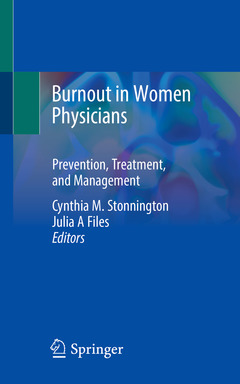Burnout in Women Physicians, 1st ed. 2020 Prevention, Treatment, and Management
Coordonnateurs : Stonnington Cynthia M., Files Julia A

This book is the first to dissect the factors contributing to burnout that impact women physicians and seeks to appropriately address these issues. The book begins by establishing the differences in epidemiology between female physicians and their male counterparts, including rates of burnout, depression and suicide, chosen fields, caregiving responsibilities at home, career tradeoffs in dual physician marriages, patient satisfaction and outcomes, academic rank, leadership positions, salary, and turnover. The second part of the book explores the drivers of physician burnout that disproportionately affect women, each chapter beginning with a case vignette. This section covers many issues that often go unrecognized including unconscious bias, sexual harassment, gender role conflicts, domestic responsibilities, depression, addiction, financial stress, and the impact related to reproductive health such as pregnancy and breastfeeding. The book concludes by focusing on strategies to prevent and/or mitigate burnout among individual women physicians across the career lifespan.This section also includes recommendations to change the culture of medicine and the systems that contribute to burnout.
Burnout in Women Physicians is an excellent resource for physicians across all specialties who are concerned with physician wellness and burnout, including students, residents, fellows, and attending physicians.
Section I. How do women physicians differ from their male counterparts?
1. Percentage women in medical school classes and fields of medicine and changes over time.
2. Patient satisfaction and outcomes (patient satisfaction, listening to patients, spending extra time when needed, adherence to clinical guidelines; outcomes such as mortality and readmission rates)
3. Rates of burnout, depression, suicide, and substance use disorders
4. Family/marriage responsibilities (reproductive life planning and management, primary caregiver for children or aging parents, career trade-offs in dual physician marriages)
5. Leadership positions6. Academic rank
7. Salary8. Turnover/years in practice
9. What has changed as greater numbers of women enter medicine, e.g., do they lose or gain power/status?
II. Drivers of burnout that disproportionately affect women (each chapter in this section will begin with a vignette and reference the evidence from the literature)
10. Unconscious bias11. Role conflict
12. Isolation13. Lack of mentorship and role models
14. Primary childcare responsibilities (and why the same may disproportionately help men)15. Hesitance to negotiate salaries, self-promote and set limits
16. Depression, stigma17. Hormonal fluctuations/menopause/pregnancy/breastfeeding
III. Solutions to empower the next generations of women (including prevention, screening, accurate diagnosis, management, and measurable outcomes)
18. Unconscious bias: increasing awareness, guides and policies
19. Reproductive life planning and management
20. Decreasing stigma associated with mental health treatment
21. Mentorship and leadership training22. Flexible schedules
23. Family leave in medical school and GME programs
24.Support networks, mothers’ support groups, and women supporting other women
25.Self-care (exercise, nutrition, sleep, and judicious use of hormone replacement when appropriate)26. Professional organizations and advocacy
26. Changing the culture from acting tough and doing it all to one of seeking help when needed, setting limits, and staying focused on the career goals that are most meaningful.Cynthia M. Stonnington
Mayo Clinic
Department of Psychiatry & Psychology
Scottsdale
Arizona
USA
Julia A Files
Mayo Clinic
Division of Women's Health Internal Med
Scottsdale
Arizona
USA
Includes case vignettes that illustrate each point
Concludes with solutions to improve prevention, treatment, and outcomes
Written by experts in women’s mental health and physician burnout
Date de parution : 07-2020
Ouvrage de 618 p.
12.7x20.3 cm



